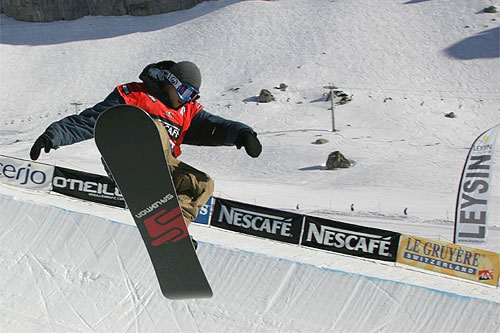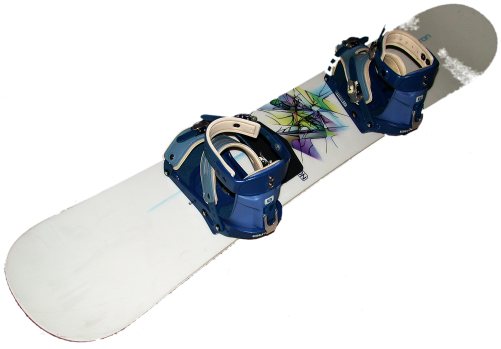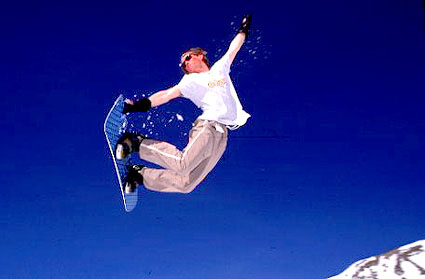
Snowboarding to the limit
Snowboarding is a sport that involves descending a snow-covered slope on a snowboard attached to a participant's feet using a special boot set into a mounted binding. It is similar to skiing, but inspired by surfing and skateboarding.
It involves riding down any terrain available. Freeriding may include aerial tricks and jib tricks borrowed from freestyle, or deep carve turns more common in alpine snowboarding - utilizing whatever natural terrain the rider may encounter.

FrEsTyLe
This style incorporates the rider with man-made terrain features such as rails, boxes, handrails, jumps, half pipes, quarter pipes and a myriad of other features. The intent of freestyle is to use these terrain features to perform a number of aerial or jib tricks.
The majority of snowboard competitions concern this style of snowboarding.
This also includes halfpipe. Halfpipe or "pipe" is a trench-like half a tube made of snow. Boarders can do a countless number of tricks in the "pipe". Some may be rotations such as a 360, or an off axis spin like a "mctwist".
FrReEcArVe/RaCe
This often overlooked style of snowboarding focuses on carving and racing. Little or no jumping takes place in this discipline.
nO Boarding
No-boarding is a young sport that replaces traditional snowboard bindings with a knobbed polymer traction pad and a heavy-duty bungee rope, which transform a snowboard into a no-board. Without highbacks to lean on or straps to hold feet in place, the pad prevents slipping, and a firm grip on the rope keeps the board in place. Staying upright is like surfing: riders adapt to pitch and snow conditions by moving their feet and center of gravity.
Competition
* Slope style
* Slope style
Snowboarding Injuries - Snowboarder's Ankle
Snowboarder's Ankle ranks second in the top 5 Injuries in Snowboarding and Skiing. Snowboarder's Ankle refers to a fracture of the lateral process of the Talus bone, which is located on the outer side of the ankle, above the heel bone. This injury is fifteen times more common in snowboarders than in the general population, hence, this injury is often termed as Snowboarder's Ankle.
With this injury, a history of an ankle sprain from Snowboarding is common. Typically, there is pain at the back on the bony prominence on the outerside of the ankle, which can be extremely tender to touch. It is usually accompanied by swelling and bruising.
With this injury, a history of an ankle sprain from Snowboarding is common. Typically, there is pain at the back on the bony prominence on the outerside of the ankle, which can be extremely tender to touch. It is usually accompanied by swelling and bruising.
Snowboarding Injuries - Wrist Fractures
Falls are more common in Snowboarding. The natural response to a fall is to stretch out a hand to break the fall, and falls tend to occur more often in beginners. For this reason, Scaphoid fractures and Colles fractures of the wrist are a relatively common feature, with around 100,000 wrist fractures worldwide among snowboarders each year.
Falls are more common in Snowboarding. The natural response to a fall is to stretch out a hand to break the fall, and falls tend to occur more often in beginners. For this reason, Scaphoid fractures and Colles fractures of the wrist are a relatively common feature, with around 100,000 wrist fractures worldwide among snowboarders each year.
ScApHoId FrAcTuRe
The scaphoid is one of the eight small carpal bones that make up the wrist complex. The fracture of the scaphoid usually occurs following a fall onto an outstretched hand.
In the case of an acute fracture of the scaphoid, the wrist is immobilized in a plaster of paris for 6 weeks. Once the cast has been removed, the patient begins physiotherapy.
CoLlEs FrAcTuRe
The Colles fracture describes a fracture of the radius bone of the forearm, just above the wrist. The most common method of sustaining a Colles fracture is to fall on an outstretched hand.
Symptoms include a great deal of pain, a "dinner fork" deformity, swelling and an inability to use the wrist and hand.
The most common treatment is simply to put the forearm and wrist into a plaster of paris for a period of 6 weeks.
 On Piste - Piste Etiquette, Guidelines, & Rules
On Piste - Piste Etiquette, Guidelines, & Rules1. Ski or snowboard under control and make sure you have enough control to be able to stop or avoid objects at will when needed. You can push your boundaries, but know your limit.
2. If you are overtaking another skier or snowboarder, it is your responsibility to avoid hitting the slower skier or rider. Take any abrupt movement of slower going people into account and make sure you have a clear picture of your surroundings at all times.
3. Do not stop, sit down or rest in the middle of the piste. If you plan to do any of them, make sure you are out of the general traffic and that other people can clearly see you.

4. When you are starting your run, give way to other skiers and snowboarders. Check your back and blind spot before entering your descent.
5. Always use supporting gear that will prevent your gear from sliding down the slope and potentially hitting other people.
6. Stick to the Rules and Piste Etiquette set out by the caretakers of the Snow Resort. Follow all Snow Resort Signs and do not enter closed trails.

7. Make sure to have a clear picture of the weather, Snowboarding Snow Conditions and the routes in the snow resort. Let those aspects dictate your Snowboarding.
8. Do not make Snowboard Jumps if you cannot see the landing site. Never ride hard into an unknown area.
10. Never go Snowboarding Off Piste alone and stay in close contact with the people you are going off slope with.
11. If you want to take Snowboarding Pictures, be sure that you are not getting in the way of other riders.






No comments:
Post a Comment